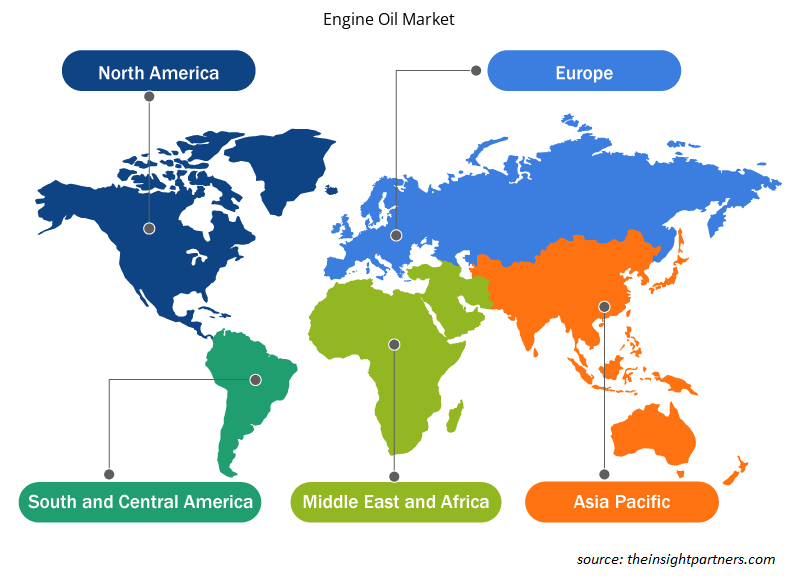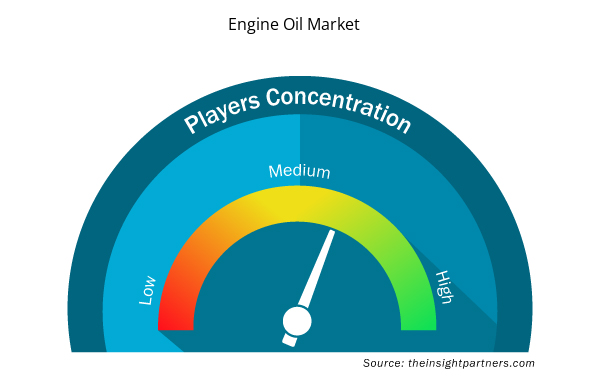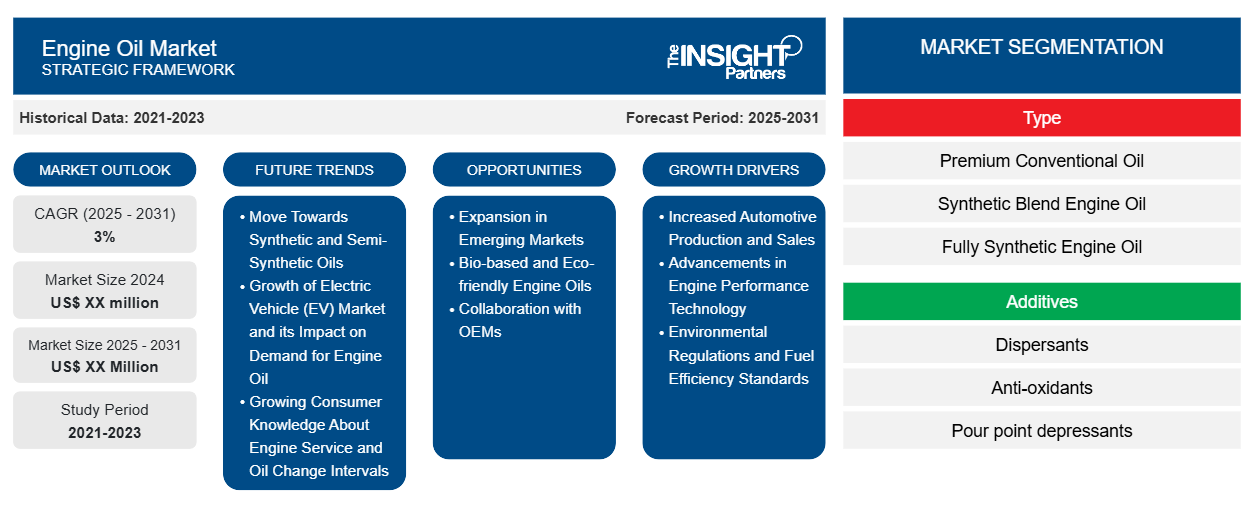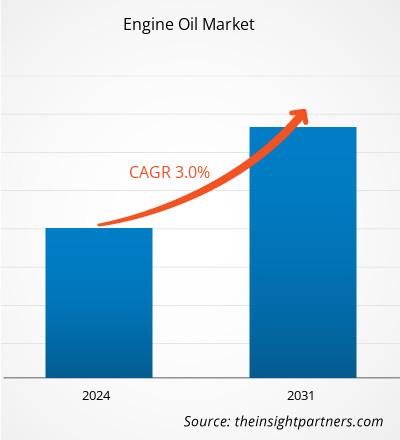Se espera que el mercado de aceite de motor registre una CAGR del 3% entre 2023 y 2031, con un tamaño de mercado que se expandirá de US$ XX millones en 2023 a US$ XX millones en 2031.
El mercado de aceite de motor cubre el análisis por tipo (aceite convencional premium, aceite de motor de mezcla sintética, aceite de motor totalmente sintético, aceite de motor de mayor kilometraje); aditivos (dispersantes, antioxidantes, depresores del punto de fluidez, inhibidores de forma, otros); industria del usuario final (generación de energía, automoción y otros transportes, equipos pesados, metalurgia y metalurgia, fabricación de productos químicos, otras industrias de usuarios finales) y geografía (América del Norte, Europa, Asia Pacífico, Oriente Medio y África, y América del Sur y Central). El motor es el componente principal de un vehículo, y los aceites de motor sirven para ser su compañero en un funcionamiento suave y eficaz.
Propósito del Informe
El informe Engine Oil Market de The Insight Partners tiene como objetivo describir el panorama actual y el crecimiento futuro, los principales factores impulsores, los desafíos y las oportunidades. Esto proporcionará información a diversas partes interesadas del negocio, como:
- Proveedores/fabricantes de tecnología: Para comprender la dinámica cambiante del mercado y conocer las oportunidades potenciales de crecimiento, lo que les permitirá tomar decisiones estratégicas informadas.
- Inversionistas: Realizar un análisis exhaustivo de tendencias sobre la tasa de crecimiento del mercado, las proyecciones financieras del mercado y las oportunidades que existen en toda la cadena de valor.
- Órganos reguladores: Regular las políticas y vigilar las actividades del mercado con el objetivo de minimizar los abusos, preservar la confianza de los inversores y defender la integridad y estabilidad del mercado.
Segmentación del mercado de aceite de motor
Tipo
- Aceite convencional premium
- Aceite de motor de mezcla sintética
- Aceite de motor totalmente sintético
- Aceite de motor de mayor kilometraje
Aditivos
- Dispersantes
- Antioxidantes
- Depresores del punto de fluidez
- Inhibidores de forma
Industria del usuario final
- Generación de energía
- Automoción y otros medios de transporte
- Maquinaria pesada
- Metalurgia y metalistería
- Fabricación de productos químicos
- Otras industrias de usuarios finales
Geografía
- América del norte
- Europa
- Asia-Pacífico
- América del Sur y Central
- Oriente Medio y África
Geografía
- América del norte
- Europa
- Asia-Pacífico
- América del Sur y Central
- Oriente Medio y África
Personalice este informe según sus necesidades
Obtendrá personalización en cualquier informe, sin cargo, incluidas partes de este informe o análisis a nivel de país, paquete de datos de Excel, así como también grandes ofertas y descuentos para empresas emergentes y universidades.
- Obtenga las principales tendencias clave del mercado de este informe.Esta muestra GRATUITA incluirá análisis de datos, desde tendencias del mercado hasta estimaciones y pronósticos.
Factores impulsores del crecimiento del mercado de aceite de motor
- Aumento de la producción y las ventas de automóviles: la industria automotriz mundial sigue siendo uno de los principales impulsores de la demanda de aceite de motor. Con el aumento de la producción y las ventas de automóviles, especialmente en mercados emergentes como China e India, la demanda de aceite de motor para vehículos nuevos y de repuesto está creciendo. El deseo de los consumidores de mantener sus vehículos y la mayor vida útil de los motores modernos también garantizan que la demanda se mantenga estable.
- Avances en la tecnología de rendimiento de motores: las mejoras continuas en la tecnología automotriz a través de motores más eficientes en el consumo de combustible, vehículos híbridos y vehículos eléctricos (VE) con motores de combustión interna (ICE) convencionales requieren tipos específicos de aceites de motor. Los aceites sintéticos de alto rendimiento, diseñados para satisfacer las demandas de la tecnología avanzada de motores, brindan un mejor ahorro de combustible, una mejor lubricación y una vida útil más prolongada del motor, lo que impulsa la demanda.
- Normas medioambientales y estándares de eficiencia de combustible: Las normas medioambientales más estrictas en materia de emisiones de combustible y eficiencia de combustible a nivel mundial están obligando a los fabricantes de automóviles a diseñar motores que requieren aceites de motor más especializados. Los aceites que reducen la fricción y mejoran la eficiencia de combustible se están volviendo esenciales para cumplir con estos requisitos normativos. Además, las normas sobre el uso de aceites de baja viscosidad han llevado a la adopción de aceites sintéticos de alta calidad.
Tendencias futuras del mercado de aceite de motor
- Avanzando hacia los aceites sintéticos y semisintéticos: los aceites de motor sintéticos están ganando más popularidad que los convencionales, ya que muestran un mejor rendimiento en temperaturas extremas, una vida útil más larga y una mayor protección para el motor. Con mejores tecnologías de formulación, los aceites sintéticos y semisintéticos ahora se están acercando en términos de precio, por lo que se adoptan cada vez más en todos los vehículos, ya sean autos de lujo o sedanes simples.
- Crecimiento del mercado de vehículos eléctricos (VE) y su impacto en la demanda de aceite de motor: si bien el crecimiento del mercado de VE tiene un efecto positivo en la demanda tradicional de aceite de motor, ha creado un cambio hacia categorías de aceite más específicas, como los aceites para transmisión y caja de cambios para vehículos híbridos. El crecimiento en el segmento de VE, por un lado, disminuirá el consumo de aceites de motor en general; sin embargo, creará oportunidades en otros productos de lubricación, como los aceites para transmisión de VE.
- Aumento del conocimiento de los consumidores sobre el mantenimiento del motor y los intervalos de cambio de aceite: como resultado de un mayor conocimiento sobre el mantenimiento del motor, los clientes están optando por cambiar el aceite con menor frecuencia y utilizar más aceite de alto rendimiento para obtener un mejor rendimiento del motor. Estas tendencias han contribuido a una mayor demanda de aceites de calidad, especialmente en mercados que rápidamente están tomando conciencia de la importancia crítica de que sus motores duren más.
Oportunidades en el mercado de aceites para motores
- Expansión en mercados emergentes: a medida que las poblaciones de clase media se expanden en regiones como Asia-Pacífico, América Latina y África, la demanda de vehículos personales y productos de mantenimiento asociados, como aceites de motor, está en aumento. Se puede llegar a esas regiones con aceites de motor rentables y de alta calidad que estén fabricados y certificados para cumplir con las especificaciones y regulaciones de cada uno de los mercados locales.
- Aceites de motor ecológicos y de base biológica: con las crecientes preocupaciones ambientales, junto con la mayor integración de prácticas de sostenibilidad, se encuentra una oportunidad significativa en el desarrollo de aceites de motor ecológicos, de base biológica y reciclables. Estos productos son ideales tanto para los clientes conscientes del medio ambiente como para las demandas regulatorias de alternativas más ecológicas.
- Colaboración con fabricantes de equipos originales: el desarrollo de aceites de motor diseñados específicamente para nuevas tecnologías de motores, como vehículos eléctricos e híbridos, con fabricantes de automóviles es una oportunidad prometedora. A medida que los fabricantes de equipos originales continúan innovando con nuevos diseños de motores, existe una demanda creciente de lubricantes especializados que se adapten a estas tecnologías.
Perspectivas regionales del mercado de aceite de motor
Los analistas de Insight Partners explicaron en detalle las tendencias y los factores regionales que influyen en el mercado de aceite de motor durante el período de pronóstico. Esta sección también analiza los segmentos y la geografía del mercado de aceite de motor en América del Norte, Europa, Asia Pacífico, Oriente Medio y África, y América del Sur y Central.

- Obtenga los datos regionales específicos para el mercado de aceite de motor
Alcance del informe sobre el mercado de aceites de motor
| Atributo del informe | Detalles |
|---|---|
| Tamaño del mercado en 2023 | XX millones de dólares estadounidenses |
| Tamaño del mercado en 2031 | US$ XX millones |
| CAGR global (2023 - 2031) | 3% |
| Datos históricos | 2021-2022 |
| Período de pronóstico | 2024-2031 |
| Segmentos cubiertos | Por tipo
|
| Regiones y países cubiertos | América del norte
|
| Líderes del mercado y perfiles de empresas clave |
|
Densidad de actores del mercado de aceite de motor: comprensión de su impacto en la dinámica empresarial
El mercado de aceite de motor está creciendo rápidamente, impulsado por la creciente demanda de los usuarios finales debido a factores como la evolución de las preferencias de los consumidores, los avances tecnológicos y una mayor conciencia de los beneficios del producto. A medida que aumenta la demanda, las empresas amplían sus ofertas, innovan para satisfacer las necesidades de los consumidores y aprovechan las tendencias emergentes, lo que impulsa aún más el crecimiento del mercado.
La densidad de actores del mercado se refiere a la distribución de las empresas o firmas que operan dentro de un mercado o industria en particular. Indica cuántos competidores (actores del mercado) están presentes en un espacio de mercado determinado en relación con su tamaño o valor total de mercado.
Las principales empresas que operan en el mercado de aceites para motores son:
- Compañía Amsoil Inc.
- Lubricantes Arabol
- Sociedad Anónima de Capital Variable (BP)
- Corporación Chevron
- Corporación Petroquímica de China
Descargo de responsabilidad : Las empresas enumeradas anteriormente no están clasificadas en ningún orden particular.

- Obtenga una descripción general de los principales actores clave del mercado de aceite de motor
Puntos de venta clave
- Cobertura integral: el informe cubre de manera integral el análisis de productos, servicios, tipos y usuarios finales del mercado de aceite de motor, proporcionando un panorama holístico.
- Análisis de expertos: el informe se compila sobre la base de un profundo conocimiento de expertos y analistas de la industria.
- Información actualizada: El informe asegura relevancia comercial debido a su cobertura de información reciente y tendencias de datos.
- Opciones de personalización: este informe se puede personalizar para satisfacer los requisitos específicos del cliente y adaptarse adecuadamente a las estrategias comerciales.
Por lo tanto, el informe de investigación sobre el mercado de aceite de motor puede ayudar a abrir el camino para descifrar y comprender el escenario de la industria y las perspectivas de crecimiento. Si bien puede haber algunas preocupaciones válidas, los beneficios generales de este informe tienden a superar las desventajas.
- Análisis histórico (2 años), año base, pronóstico (7 años) con CAGR
- Análisis PEST y FODA
- Tamaño del mercado Valor/volumen: global, regional, nacional
- Industria y panorama competitivo
- Conjunto de datos de Excel


- Skin Tightening Market
- Vision Care Market
- Semiconductor Metrology and Inspection Market
- Rugged Servers Market
- Virtual Production Market
- Identity Verification Market
- Hydrocephalus Shunts Market
- Electronic Data Interchange Market
- Artificial Intelligence in Defense Market
- Visualization and 3D Rendering Software Market

Report Coverage
Revenue forecast, Company Analysis, Industry landscape, Growth factors, and Trends

Segment Covered
This text is related
to segments covered.

Regional Scope
North America, Europe, Asia Pacific, Middle East & Africa, South & Central America

Country Scope
This text is related
to country scope.
Preguntas frecuentes
Based on geography, North America held the largest share of the engine oil market due to the the vast automotive industry in the region.
The premium conventional oil type segmnet accounted for the largest market share in 2023.
Amsoil Inc, Arabol Lubricants, BP PLC, Chevron Corporation, China Petrochemical Corp, ExxonMobil Corporation, Lukoil Company, Royal Dutch Shell, Sinolec Lubricant Company, Total SA are some of the key players operating in the market.
The growing need for maintainance of automotive vehicles is a key driver in the market.
The Engine Oil Market is estimated to witness a CAGR of 3% from 2023 to 2031
Stringentfavorable government policies is an emerging trend in the market.
Trends and growth analysis reports related to Chemicals and Materials : READ MORE..
1. Amsoil Inc.2. Arabol Lubricants3. BP PLC4. Chevron Corporation5. China Petrochemical Corp6. ExxonMobil Corporation7. Lukoil Company8. Royal Dutch Shell9. Sinolec Lubricant Company10. Total SA
The Insight Partners performs research in 4 major stages: Data Collection & Secondary Research, Primary Research, Data Analysis and Data Triangulation & Final Review.
- Data Collection and Secondary Research:
As a market research and consulting firm operating from a decade, we have published and advised several client across the globe. First step for any study will start with an assessment of currently available data and insights from existing reports. Further, historical and current market information is collected from Investor Presentations, Annual Reports, SEC Filings, etc., and other information related to company’s performance and market positioning are gathered from Paid Databases (Factiva, Hoovers, and Reuters) and various other publications available in public domain.
Several associations trade associates, technical forums, institutes, societies and organization are accessed to gain technical as well as market related insights through their publications such as research papers, blogs and press releases related to the studies are referred to get cues about the market. Further, white papers, journals, magazines, and other news articles published in last 3 years are scrutinized and analyzed to understand the current market trends.
- Primary Research:
The primarily interview analysis comprise of data obtained from industry participants interview and answers to survey questions gathered by in-house primary team.
For primary research, interviews are conducted with industry experts/CEOs/Marketing Managers/VPs/Subject Matter Experts from both demand and supply side to get a 360-degree view of the market. The primary team conducts several interviews based on the complexity of the markets to understand the various market trends and dynamics which makes research more credible and precise.
A typical research interview fulfils the following functions:
- Provides first-hand information on the market size, market trends, growth trends, competitive landscape, and outlook
- Validates and strengthens in-house secondary research findings
- Develops the analysis team’s expertise and market understanding
Primary research involves email interactions and telephone interviews for each market, category, segment, and sub-segment across geographies. The participants who typically take part in such a process include, but are not limited to:
- Industry participants: VPs, business development managers, market intelligence managers and national sales managers
- Outside experts: Valuation experts, research analysts and key opinion leaders specializing in the electronics and semiconductor industry.
Below is the breakup of our primary respondents by company, designation, and region:

Once we receive the confirmation from primary research sources or primary respondents, we finalize the base year market estimation and forecast the data as per the macroeconomic and microeconomic factors assessed during data collection.
- Data Analysis:
Once data is validated through both secondary as well as primary respondents, we finalize the market estimations by hypothesis formulation and factor analysis at regional and country level.
- Macro-Economic Factor Analysis:
We analyse macroeconomic indicators such the gross domestic product (GDP), increase in the demand for goods and services across industries, technological advancement, regional economic growth, governmental policies, the influence of COVID-19, PEST analysis, and other aspects. This analysis aids in setting benchmarks for various nations/regions and approximating market splits. Additionally, the general trend of the aforementioned components aid in determining the market's development possibilities.
- Country Level Data:
Various factors that are especially aligned to the country are taken into account to determine the market size for a certain area and country, including the presence of vendors, such as headquarters and offices, the country's GDP, demand patterns, and industry growth. To comprehend the market dynamics for the nation, a number of growth variables, inhibitors, application areas, and current market trends are researched. The aforementioned elements aid in determining the country's overall market's growth potential.
- Company Profile:
The “Table of Contents” is formulated by listing and analyzing more than 25 - 30 companies operating in the market ecosystem across geographies. However, we profile only 10 companies as a standard practice in our syndicate reports. These 10 companies comprise leading, emerging, and regional players. Nonetheless, our analysis is not restricted to the 10 listed companies, we also analyze other companies present in the market to develop a holistic view and understand the prevailing trends. The “Company Profiles” section in the report covers key facts, business description, products & services, financial information, SWOT analysis, and key developments. The financial information presented is extracted from the annual reports and official documents of the publicly listed companies. Upon collecting the information for the sections of respective companies, we verify them via various primary sources and then compile the data in respective company profiles. The company level information helps us in deriving the base number as well as in forecasting the market size.
- Developing Base Number:
Aggregation of sales statistics (2020-2022) and macro-economic factor, and other secondary and primary research insights are utilized to arrive at base number and related market shares for 2022. The data gaps are identified in this step and relevant market data is analyzed, collected from paid primary interviews or databases. On finalizing the base year market size, forecasts are developed on the basis of macro-economic, industry and market growth factors and company level analysis.
- Data Triangulation and Final Review:
The market findings and base year market size calculations are validated from supply as well as demand side. Demand side validations are based on macro-economic factor analysis and benchmarks for respective regions and countries. In case of supply side validations, revenues of major companies are estimated (in case not available) based on industry benchmark, approximate number of employees, product portfolio, and primary interviews revenues are gathered. Further revenue from target product/service segment is assessed to avoid overshooting of market statistics. In case of heavy deviations between supply and demand side values, all thes steps are repeated to achieve synchronization.
We follow an iterative model, wherein we share our research findings with Subject Matter Experts (SME’s) and Key Opinion Leaders (KOLs) until consensus view of the market is not formulated – this model negates any drastic deviation in the opinions of experts. Only validated and universally acceptable research findings are quoted in our reports.
We have important check points that we use to validate our research findings – which we call – data triangulation, where we validate the information, we generate from secondary sources with primary interviews and then we re-validate with our internal data bases and Subject matter experts. This comprehensive model enables us to deliver high quality, reliable data in shortest possible time.


 Obtenga una muestra gratuita de este informe
Obtenga una muestra gratuita de este informe